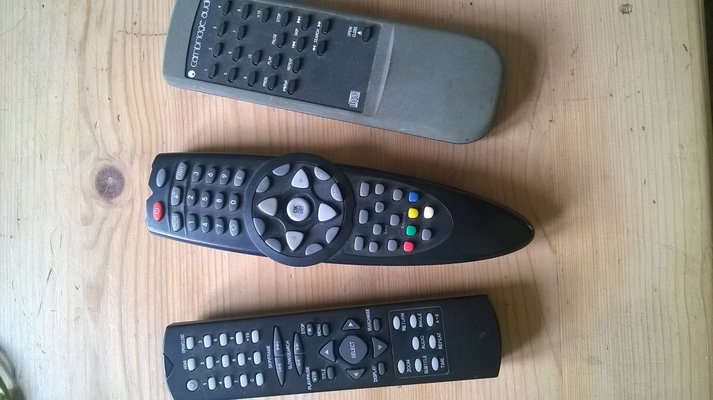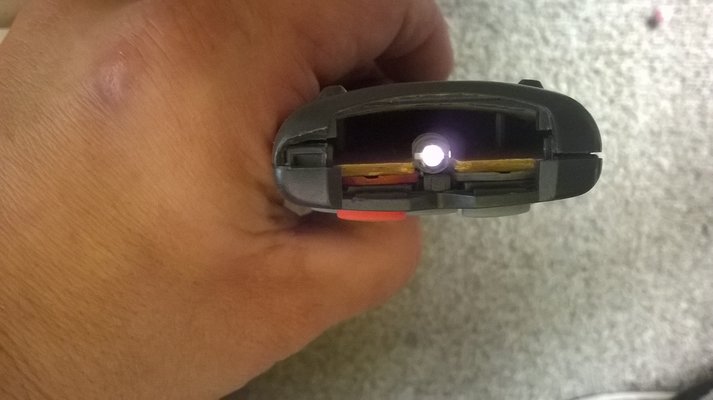eSCHEn
Bit Wrangler
- Messages
- 6,136
- Location
- SW Scotland
Sometimes you'd like to test your mask but you haven't got a handy bright light to trigger it. Here's a method using something most people have around about the place.
Testing a Mask
What you'll need to test your helmet is a remote control. It doesn't matter if it's from your TV, VCR, HiFi or anything else. All it needs to do is produce an IR signal.
 Any of these will do
Any of these will do
Set up your mask how you'd like and then look through it as usual. Aim the remote control at your face and press a few buttons. Your mask should go into its dark state and stay there whilst you hold a button down. If you get nothing at all then try increasing the mask's sensitivity as high as it will go. If you still get no joy then you should test the remote control is working - see the next section.
It's worth mentioning that remote controls don't send a constant stream of IR. It's a pulsed signal so if the remote control's pulses are slow and your mask's delay is set very low then you /might/ get flickering as the mask jumps in and out of its dark state. If this happens then try turning the delay up and re-test.
Testing the Tester
You can test that the remote control is actually working by aiming it at a digital camera when you're looking through the camera's screen (the optical viewfinder won't work). The IR from the remote control makes a pinky/purple light on the screen. That way you know it's working.
 Don't look too long or you'll end up in another dimension!
Don't look too long or you'll end up in another dimension!
Glossary
Testing a Mask
What you'll need to test your helmet is a remote control. It doesn't matter if it's from your TV, VCR, HiFi or anything else. All it needs to do is produce an IR signal.
 Any of these will do
Any of these will doSet up your mask how you'd like and then look through it as usual. Aim the remote control at your face and press a few buttons. Your mask should go into its dark state and stay there whilst you hold a button down. If you get nothing at all then try increasing the mask's sensitivity as high as it will go. If you still get no joy then you should test the remote control is working - see the next section.
It's worth mentioning that remote controls don't send a constant stream of IR. It's a pulsed signal so if the remote control's pulses are slow and your mask's delay is set very low then you /might/ get flickering as the mask jumps in and out of its dark state. If this happens then try turning the delay up and re-test.
Testing the Tester
You can test that the remote control is actually working by aiming it at a digital camera when you're looking through the camera's screen (the optical viewfinder won't work). The IR from the remote control makes a pinky/purple light on the screen. That way you know it's working.
 Don't look too long or you'll end up in another dimension!
Don't look too long or you'll end up in another dimension!Glossary
- Sensitivity: How much light is needed to trigger the mask into its dark state. LOW sensitivity means it requires comparatively LARGE amounts of light to trigger the change. HIGH sensitivity means only a SMALL amount of light is needed to go dark.
- Shade: When the mask it in its dark state this number tells you how dark that is. The larger the number the darker the shade. Shade 9 to 13 is a common range that most auto-darkening masks will adjust to.
- Delay: Once the light from the arc stops then this is how long it takes to revert back to the light state on the mask. If you're welding something at a high power then it's likely to glow and be too bright too look at straight after welding. In this case you increase the delay and the extra time it takes the mask to go into its light state allows the material to dim enough to not be uncomfortable when you get back into the light state.
- Grind Mode: Not all masks have this feature but those that do have a switch on them that allows the auto-darkening sensors to be disconnected temporarily. This means that when you're in grind mode the mask will not darken and stays in its light state. Usually this is about shade five and it means you can flick a switch to do a bit of grinding then flick it back and weld again without needing to change mask.








 Just try welding,
Just try welding, if you cant see after,
if you cant see after, --------- it's definitely not working
--------- it's definitely not working  just to be on safe side just use one eye
just to be on safe side just use one eye

